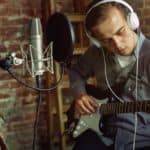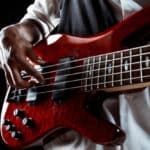How do you become an at-home Rock Star without getting an eviction notice?
There is a myriad of ways to quietly play electric guitar in your apartment; from practice amps with headphone outs and VSTs plugins on your computer to soundproofing and silent practice techniques such as muffling an acoustic guitar. Negotiating with your neighbors is also a great alternative.
So, put on your headphones and pull out some soundproof foam. Let’s make your neighbors happy.
How to play electric guitar quietly?
This question has plagued guitarists since the first strings were plucked, thankfully modern technology is absolutely on your side. There are so many options that allow you to silently shred the night away without getting that dreaded knock on the door.
The best part is these options are available in all price ranges. No matter what your situation is, we here at Gear Aficionado will have you quietly crushing in no time.
Headphones
First and foremost is headphones. A well-designed set of headphones will make many solutions not only possible but also pleasurable. When it comes to late-night shred sessions headphones are integral.
Many modern “practice” amps offer a headphone out (i.g. Boss Katana) and there are also V.S.T plugins; software that turns your computer or phone into a virtual amp. All of these will make silent playing an absolute breeze.
But regardless of what option you take, the headphone’s speakers will be the last thing to affect your tone before it hits your ears. Thus, it is worth investing in a good quality set.
I highly recommend larger speaker headphones that fit over the ear. The larger speaker diaphragm allows for a broader frequency spectrum, with fuller low end and less shrill highs.
The larger over-ear design is more comfortable due to the padding and also far less fatiguing since the tone is not being actively crammed into your ear canal.
There are two major styles of headphones; Studio Monitor & Hi-fi.
Studio Monitor Headphones
These will give you an earnest and un-tampered tone, letting you tailor the sound via your V.S.T or amp. They are also far easier to repair due to their simple design.
I recommend these, as you can pick up a quality set for a very reasonable price and they’ll last you a long time.
Hi-fi Headphones
Regular headphones will color the tone, generally adding bass and their own EQ.
This makes them more pleasing for listening to music but they do not give a true representation of the tone when playing and can sometimes not process direct guitar tone well.
Virtual Amps and V.S.Ts
Now that you have your headphones, the next question is “what do I play through?”
For price and convenience, you cannot beat a good V.S.T program.
V.S.T stands for Virtual Sound Technology, in this case, a virtual guitar rig. All you need to run this software is a computer/device and a cheap audio interface.
These programs put a wealth of tones at your figure tips and will easily interact with your recording software, turning your laptop into a mobile studio.
This option will have you finding so many creative and productive uses. Most notably, silently recording quality guitar tracks in your home.
My absolute top recommendation is to check out Neural DSP, they are the highest quality and have a killer range.
However, if you do not have a laptop or desktop computer, Bias Amp Mobile is free on the app store for iPhone and iPad. The only required equipment is a guitar cable and a small, portable, and inexpensive interface like the iRig2 (just make sure it is compatible with your device).
Best practice amps with headphone outs.
If V.S.Ts and D.A.Ws sound too high-tech for your needs, a good quality practice amp with a headphone out will hit the spot.
Amps like the Boss Katana and Yamaha THR10 series offer not only a plug for your headphones but also an AUX IN so you can play along with whatever your heart desires.
When played without headphones, both these amps (particularly the Yamaha THR10) will give a large and enjoyable tone, all at a volume that pleases your neighbors and your ear doctor.
To sweeten the deal, they can be used as an audio interface with your computer. This gives you the much-desired ability to silently record.
Headphone Amps
A compact headphone amp is a simple solution to this quandary, plug it directly into your guitar or FX pedals.
Although, whilst some of them are affordable, their cost is hard to justify, especially when compared to a free V.S.T for your phone (Bias Mobile) and an iRig that allows you to record.
In this field, two items stand head and shoulders above the rest.
Fender Mustang Micro
If convenience and usability are in the front of your mind, check out the very creative Fender Mustang Micro which has multiple amp/FX sims and allows you to record into your DAW. Its ability to form great sound is well regarded.
Boss Waza Air
The absolute pinnacle of this style of amp is the Boss Waza Air headphones, a high-quality set of headphones with inbuilt amps and FX. It is effortlessly controlled by your phone and extremely dynamic.
And of course, the price reflects that.
It is astronomical in price… in fact, for the same price, you could start a full home studio setup (everything besides the computer).
Attenuators
If you are the type of player that will always choose the glory of Class A tube amps over digital technology, then an attenuator is a must-have.
An attenuator controls the amount of power that reaches a speaker. This lets the amp warm up into its full volume tones (soaking the power tubes etc.) but at a much lower volume.
This won’t be a silent option but it will mean you can fire up your favorite amp at home to play and (most importantly) record.
How to play acoustic guitar quietly?
Whilst electric guitar has a plethora of silent solutions, the acoustic guitar is an entirely different issue. Its self amplified nature yields a host of problems for apartment dwelling strummers, but don’t fret, you are not stranded without hope.
Nylon String Guitars
The brighter tones of steel strings and larger construction of many acoustic guitars will carry the noise far further than the soft and subtle puck of nylon strings.
Investing in a cheap nylon guitar will let you indulge when inspiration strikes late at night.
It also leads perfectly to our next suggestion.
Fingerpicking
Try to experiment with fingerpicking rather than strumming loudly away. Not only is it quieter, but you will also discover a whole new side to your instrument and might find some new style to work within.
String Dampeners/Soundhole Covers
These tools will reduce the volume of your acoustic guitar. Though, in the case of the string dampener/string muter, you will find that it also greatly affects your tone.
Whenever you interrupt the vibration of the string you will hear buzzing.
The soundhole cover is much more appropriate and useful, as it’ll be particularly handy if you use that acoustic live.
Find the best time to practice
Not everyone has the same schedule. If you talk to your neighbors you might be pleasantly surprised, they may have obligations of their own.
Take the opportunity to practice loudly and proudly when you know they are not home. Besides, the simple act of asking them shows that you respect their situation and that respect can go a long way.
The better your relationship with the neighbors is, the more understanding they will be when you play guitar a touch too loud.
Negotiate with your neighbors
Offer a trade, if they don’t complain about your noise, you don’t tell their husband or wife about them sneaking out at night.
All jokes aside, setting up boundaries with those around you can be very beneficial.
It creates a set of rules that will guarantee you ample time to play guitar and gives your neighbors an agreement to abide by.
So if they do knock on your door, you can point at the agreement and say “I’m still within my allotted time”.
But this all only works if your neighbors are good and understanding people. There are some neighbors that you can never please.
Sometimes you have a neighbor from hell.
In that case, there is only one sure-fire option.
Know the law!
Knowing the local laws around noise and music is the greatest weapon you can have in this fight.
All it takes is a small amount of research or even a call to your council or nearby police.
Most local governments and councils will have their legal acts and documents available online.
You most likely find a law that states when certain noises are allowed and what times they are prohibited particularly musical noise.
Copy and memorize this passage so you can, simultaneously, work within the law and stand up for your right to play music.
If you have an unreasonable neighbor that complains every time a cat meows, you can rest easy knowing you are doing the right thing and the law is on your side.
But… If you are like me and do enjoy playing guitar a little bit late and a little bit loud, then the next option is a must.
Sound Proofing
This is a subject worthy of an entire article itself.
Acoustically setting up your apartment can drastically reduce the amount of noise that escapes (and the noise that gets in, making your recordings far cleaner).
There are so many easy and affordable ways to audio dampen your home.
Bookshelves
Placing a loaded bookshelf against the wall that you share with neighbors, will act as a sponge for the sound waves (especially if the book spines are facing the wall, letting the open pages absorb more sound).
Soundproof Curtains
Either purchase or create your own foam-filled curtains that will stop vibrations from hitting the most sound-sensitive part of your home, the windows.
Seal Your Doors & Windows
Use adhesive foam strips to seal the gaps around your opening windows and under your doors.
This prevents direct leaking of the sound through cracks.
Sound Traps
By using dense foam panels that absorb the sound waves you can add a further barrier between you and your neighbor and give the sound waves more places to dissipate.
Whilst one of these solutions will not solve your issues, all of them working in tandem will make a difference.
Exercises to improve your playing if you can’t play your guitar.
During times when it is not appropriate or possible to audibly play guitar, there are other things you can do to keep up with your practice.
Fretting Only
Beginner guitarists will be able to improve their hand/finger mobility by simply fretting chords and scales without picking.
This might seem very unsatisfying but finger flexibility is one of the biggest hurdles that guitarists face in their early years.
The secret to this style of exercise is to be very truthful to yourself. Admit it when you have hit a wrong fret and you will see some actual progression from this.
This is a situation that is specific to beginners, though more established players can find ways to improve without laying their hands on a guitar.
Improve/Test Your Theory
As studious as this is to say, a good foundation of theory will allow you to approach the guitar with fresh ears.
Read about a specific aspect of theory and plan your next playing session around it.
Improve Your Guitar Knowledge
There are more dimensions to being a guitarist than simply playing guitar, you should find out about new guitar techniques, technology, and artistic approaches.
Simply put you can always read more GearAficionado.
Finding A Better Location
If all else fails and you want to be truly loud and unencumbered by neighbors, try finding a space that allows this.
Many rehearsal rooms offer cheap rates for solo booking (especially on the day), this gives you the space to turn up to 11 and test out your rig… and also just have fun.
If you are ever in doubt about what to do in this situation, ask a drummer.
They have honestly been through all of these issues and often have creative ways to work around t

Hello there, my name is Ramiro and I’ve been playing guitar for almost 20 years. I’m obsessed with everything gear-related and I thought it might be worth sharing it. From guitars, pedals, amps, and synths to studio gear and production tips, I hope you find what I post here useful, and I’ll try my best to keep it entertaining also.





